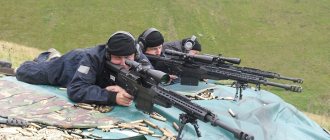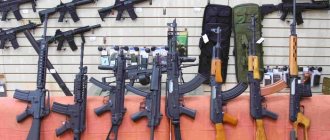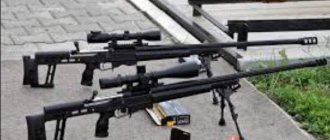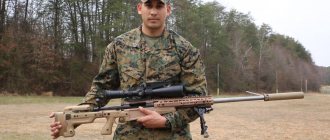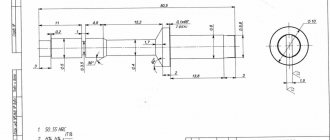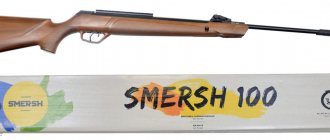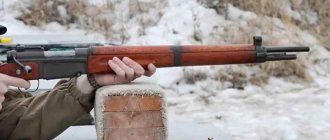In 1959, a shooting model designed by the legendary Soviet weapons designer M. T. Kalashnikov was proposed as a prototype sniper rifle. In the technical documentation, the product is listed as SVK (Kalashnikov sniper rifle). This rifle unit was developed in two versions. The rifles differed in their handles: pistol and semi-pistol types. Information about the history of creation, design and tactical and technical characteristics of the SVK rifle is presented in this article.
[edit] History of creation
In the second half of the twentieth century, personal protective equipment was widely used in the armies of the leading countries of the world. Therefore, much attention was paid to increasing the penetrating effect of the bullet, as well as increasing the accuracy of fire. At the same time, it was found that in addition to the characteristics of the “cartridge-weapon” complex, the magnitude of bullet dispersion is greatly influenced by shooting errors, among which the most significant are errors in determining the range to the target and the speed of the side wind. The effect of these errors on shooting accuracy depends on the external ballistic characteristics of the ammunition - the range of a direct shot and the flight time of the bullet.
Based on these considerations, in the 1980s, Soviet designers developed a 6 mm caliber rifle cartridge (6x49), the initial speed of a 5 gram bullet was 1150 m/s. The length of the 6x49 mm cartridge is 70.5 mm, and the weight is 16.4 g. Thanks to the increase in the initial velocity, the external ballistic characteristics of the cartridge have improved, the probability of hitting a target has increased due to a flatter trajectory and a decrease in the bullet’s flight time.
At the same time, in Izhevsk, at the Izhmash production association, work began on creating an experimental self-loading sniper rifle using a new 6-mm cartridge. The new weapons were given the designation SVK and SVK-S (a modification of a rifle with a folding stock), the development of which was undertaken by a design group consisting of A.I. Nesterova, V.Yu. Simonenko, A.S. Lomaeva, O.N. Kivamova.
As part of the development program for a sniper rifle for the new 6-mm rifle cartridge, strict requirements were put forward that limited the dimensions of the weapon along the length, which was due to the need for optimal placement of the rifle in the compartments of infantry fighting vehicles and to ensure the possibility of airborne snipers landing with weapons. According to the requirements of the technical specifications, the length of the rifle barrel (based on the specified initial bullet speed of 1150 m/s) was supposed to be 720 mm, while the total length of the weapon was limited to 1225 mm.
Initially, it was planned to modify the SVD rifle for the new cartridge. However, the total length of the SVD (with a barrel length of 620 mm) is 1220 mm, and if the barrel length were increased to 720 mm, it would increase to 1320 mm. In addition, the layout of the automation mechanisms adopted in the SVD rifle, in which the bolt frame is based and guided in a long receiver, does not allow for a reduction in the overall length of the weapon by reducing the length of the receiver.
Therefore, when designing a 6-mm sniper rifle, which was based on the classic layout of the weapon, the task arose to reduce the length of the receiver as much as possible, especially since the parameters of the technical specifications made it possible to do this.
After preliminary study of the design, it was decided to settle on an automation scheme with the removal of part of the powder gases from the barrel bore. A rotating bolt with two lugs was chosen, which made it possible to bring the magazine as close as possible to the chamber and thereby reduce the length of the receiver.
The location of the leading lug of the rotating bolt in the curvilinear groove of the bolt frame suggests three schemes for basing the bolt frame in the weapon:
- in the rear part, the bolt frame is based in grooves that are made outside the receiver, and in the front part, under the barrel, in a gas tube (American Garanda M1 self-loading rifle);
- in the front and rear parts the bolt frame is based on guide lugs inside the receiver (SVD sniper rifle);
- in the rear part, the bolt frame is based on guide lugs located inside the receiver, and in the front part - in the gas tube above the barrel (AK assault rifle).
From the point of view of reducing the length of the receiver, of all the above schemes for basing the bolt frame, the most optimal is the layout adopted in Kalashnikov assault rifles. However, the large mass of moving parts, their impact through the gas outlet tube on the barrel at the time of the shot, and some uncertainty about the location of the moving parts in the forward position do not allow the scheme to be fully implemented in high-precision sniper weapons.
Therefore, a new scheme for basing the bolt frame and the direction of its movement was invented. The SVK bolt frame is based in the rear part on guide protrusions made inside the receiver, and in the front part, through a hole in it, on the guide rod of the return spring. At the same time, it was possible to significantly reduce the length of the receiver. The length of the SVK (SVK-S) receiver was 273 mm, in contrast to 315 mm for the SVD[1].
In September 2020, the Kalashnikov concern, part of the Rostec State Corporation, presented for the first time a prototype of a new self-loading sniper rifle, the SVK, as part of the International Military-Technical Forum Army 2016. [2]
The 6-mm sniper rifle SVK (SVK-S) passed a full cycle of factory tests in difficult operating conditions, which confirmed the functionality of the selected automation scheme.
The American magazine The National Interest included the SVK rifle in the TOP 5 of the “Weapons of the Future” rating, which could be equipped with the Russian army by 2030. According to the author of the rating, Kyle Mizokami, the SVK rifle will replace the famous Dragunov rifle (SVD), which has been in service since 1963[3].
Combat use
| date | Event |
| 1962 - 1966 | Actively used by the British Army in the Indonesian-Malaysian conflict |
| 1965 | Used by the US Army in Vietnam |
| 1973 | Use by the Egyptian Armed Forces in Operation Doomsday |
| 1980 – 1988 | Use by Iranian armed forces in the Iran-Iraq War |
| 1979 – 1989 | Used by the US Army and Afghan armed groups |
| 1990 – 1991 | The US Army used the M16A3 modification in the Persian Gulf area |
| 2003 – 2011 | The M16 was in service with the US Army in Iraq |
[edit] Operating principle and device
The compact self-loading sniper rifle SVK is being developed in two versions, chambered for the domestic 7.62x54R cartridge and for the most common rifle cartridge in the world, 7.62x51 NATO.
The rifle has an “inverted” layout with a U-shaped steel receiver, in which the bolt group is located in a “suspended” state. The weapon's automatic system uses a short-stroke gas piston and a rotating bolt with three lugs. The design includes a manual gas regulator, ensuring reliable and comfortable shooting, both in a conventional configuration and with a silencer installed.
Cartridges are supplied from detachable box magazines of standard (10 rounds) and increased (15 or 20 rounds) capacity. In the version chambered for 7.62x54R, SVK magazines are interchangeable with the Dragunov SVD rifle.
The rifle has ambidextrous weapon controls. The upper surface of the receiver has a Picatinny rail for installing modern sighting systems. Open sights, if necessary, can be installed on the same bar. The plastic adjustable stock folds to the side. The rifle can be equipped with a quick-detachable tactical silencer and a folding bipod[4].
The SVK used a design that ensures the so-called “suspended” barrel. Ideally, the barrel should not touch any parts of the rifle at all except where it connects to the receiver. In the case of a gas vent, this is impossible, but the designers managed to eliminate contact between the barrel and the forend, which had a positive effect on the shooting results.
In order to reduce the overall length of the weapon, a short slotted flame arrester in the form of a bell was developed, the length of the working area of which was 29 mm (compared to 78 mm on the SVD).
In the design of the sniper rifle, technical solutions were used that eliminate the negative effects of the fore-end, butt and receiver cover on the weapon at the time of the shot and, thereby, increase the accuracy of fire.
The SVK rifle uses a permanent frame stock, the front edge of which forms a pistol grip. To arm the airborne troops, a variant of the SVK-S rifle was developed with a stock made of steel pipes folding onto the left side of the receiver. On the top tube of the butt there is a rotating plastic support for the shooter's cheek, which is used when shooting with an optical sight.
The forend, consisting of two halves, equipped with a large number of holes and serving for cooling, is made of plastic.
The safety lever, similar to the SVD, is located on the right side of the weapon.
The rifle is equipped with fixed open sights in the form of a front sight in the front sight and an adjustable rear sight located in front of the receiver cover. The bracket for the optical sight is attached to the receiver on the left.
Rifle SK-16 - weapons designer
The SK-16 self-loading carbine is a modular weapon in which any components can be easily and quickly changed. This allows you to customize the weapon according to the shooter’s mission and purpose, as well as carry out repairs and change configurations right during the battle.
This project contains a lot of exciting solutions that have not been used anywhere before, but despite this, they have the highest attractiveness in the field of tool production. The first assembled and working copy of the SK-16 has already been presented to the high authorities of the Russian Federation and is being prepared for mass production.
custom_block(1, 42847676, 8782);
[edit] Performance characteristics
According to the designers, in general, the technical specifications for the development of the SVK (SVK-S) sniper rifle were completed successfully. Good results were achieved in terms of shooting accuracy. When shooting at a distance of 100 m lying down from a rest using an optical sight in three series of 10 shots, the accuracy of fire was R100 - 5.5 cm, R50 - 2.3 cm (where R100 and R50 are the radii of a circle containing 100 and 50% of the holes, respectively ).
The superiority of the SVK rifle over the SVD rifle in terms of damage was:
- 1.33 at a shooting distance of 630 m,
- 1.73 at a shooting distance of 770 m,
- 3.89 at a shooting distance of 970 m,
- 3.89 at a shooting distance of 1030 m.
On average for all lines, the superiority for a particular defeat was 2.32.
In addition, the length of the SVK and SVK-S in the combat position (1188 mm) was shorter than the SVD (1220 mm), despite the fact that the barrel length was increased by 100 mm, and the length of the aiming line by 80 mm (667 mm for the SVK and 587 mm for the SVD ). However, at the same time, the weight of the rifle without cartridges and an optical sight increased: SVK to 4.2 kg and SVK-S to 4.3 kg, compared to 3.8 kg for the SVD.
After field tests, some shortcomings of the 6-mm cartridge were also noted, which needed improvement. However, by the end of the 1980s, the USSR entered a period of protracted economic crisis, funding for the defense complex was sharply reduced, and all work on the cartridge and rifle was stopped.
However, the design solutions used in the 6-mm SVK and SVK-S sniper rifles were not in vain. The folding frame stock, as well as the short-barreled flash suppressor, tested on the SVK-S rifle, were later used on the SVD-S rifle. In addition, a compact slotted flash suppressor of this design was used on the Tiger-9 hunting carbine and the Bison-2 submachine gun.
| TTX | SVK | SVK-S |
| Caliber, mm | 6x49; 7.62x54 mm R; 7.62×51mm NATO | 6x49 7.62x54 mm R; 7.62×51mm NATO |
| Length, mm stock unfolded/stock folded | 1188 | 1188/960 |
| Barrel length, mm | 720 | 720 |
| Weight without cartridges and sight, kg | 4.2 | 4.3 |
| Store, count. cartridges | 10 | 10 |
| Initial bullet speed, m/s | 1150 | 1150 |
Non-adoption
The Kalashnikov rifle, although it outperformed the Dragunov rifle in terms of weight and size, did not meet the requirements for accuracy of fire and remained experimental. The main contenders were rifles from Izhevsk designer E.F. Dragunov (who had previously participated in the production of the AK assault rifle at the Izhevsk Machine-Building Plant) and Kovrov designer A.S. Konstantinov. After much testing and fine-tuning in 1963, the Dragunov sniper rifle was adopted.
